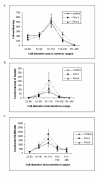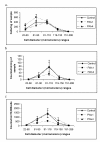Periodic 48 h feed withdrawal improves glucose tolerance in growing pigs by enhancing adipogenesis and lipogenesis
- PMID: 22321818
- PMCID: PMC3292934
- DOI: 10.1186/1743-7075-9-10
Periodic 48 h feed withdrawal improves glucose tolerance in growing pigs by enhancing adipogenesis and lipogenesis
Abstract
Background: Adipocyte numbers and peroxisome proliferators activated receptorγ (PPARγ) expression of retroperitoneal tissue increased while area under the curve (AUC) during the glucose tolerance test (GTT) was reduced in rats subjected to certain feed withdrawal (FW) regimens. Thus, using pigs as the experimental model, the hypothesis that FW regimens influence glucose tolerance by influencing fat cell function was evaluated with the objective of determining the effect of a single (FWx1; at age of 19 wk for 48 h) or periodic, multiple (FWx4; 24 h FW at 7 and 11 wk of age and 48 h FW at 15 and 19 wk of age) FW on AUC of glucose and insulin during the GTT relative to pigs that did not experience FW (Control).
Methods: Growth, body composition, adipocyte numbers, PPARγ expression, lipogenic potential as glucose uptake into fat of adipocytes of varying diameter in omental (OM) and subcutaneous (SQ) fat as affected by FW regimens were determined in pigs initiated into the study at 5 wk of age and fed the same diet, ad libitum.
Results: Blood glucose concentrations for prior to and 120 min post glucose meal tended to be lower (p = 0.105 and 0.097, respectively) in pigs in FW treatments. In OM fat; cell numbers, glucose Universal14C [U14C] incorporation into fat and rate of incorporation per 104 cells was greatest for cells with diameters of 90-119 μm. Pigs undergoing FWx4 tended to have greater (p = 0.0685; by 191%) number of adipocytes, increased (p = 0.0234) glucose U14C incorporation into adipocytes and greater (p = 0.0872) rate of glucose uptake into cells of 119-150 μm diameter than of cells from control or FWx1 pigs. Subcutaneous adipocyte numbers in 22-60 and 61-90 μm diameter ranges from pigs in FWx1 tended to be greater (p = 0.08 and 0.06, respectively) than for those in FWx4 treatment, yet PPARγ expression and total cell number were not affected by treatment.
Conclusions: Results suggest that FW regimens influence fat cell function or lipogenesis rather than number, affecting glucose metabolism and may have implications in drug-free control of metabolic syndrome symptoms.
Figures





Similar articles
-
Feed withdrawal abate regimens lipodystrophy and metabolic syndrome symptoms, such as glucose tolerance, are associated with the diameter of retroperitoneal adipocytes in rats.Nutr Res. 2010 Feb;30(2):125-33. doi: 10.1016/j.nutres.2009.09.009. Nutr Res. 2010. PMID: 20226998
-
Effect of source and amount of energy and rate of growth in the growing phase on adipocyte cellularity and lipogenic enzyme activity in the intramuscular and subcutaneous fat depots of Holstein steers.J Anim Sci. 2004 Jan;82(1):137-48. doi: 10.2527/2004.821137x. J Anim Sci. 2004. PMID: 14753357
-
Effect of full feed and early feed restriction on broiler performance, abdominal fat level, cellularity, and fat metabolism in broiler chickens.Poult Sci. 1995 Oct;74(10):1636-43. doi: 10.3382/ps.0741636. Poult Sci. 1995. PMID: 8559728
-
Phytol increases adipocyte number and glucose tolerance through activation of PI3K/Akt signaling pathway in mice fed high-fat and high-fructose diet.Biochem Biophys Res Commun. 2017 Aug 5;489(4):432-438. doi: 10.1016/j.bbrc.2017.05.160. Epub 2017 May 29. Biochem Biophys Res Commun. 2017. PMID: 28571740
-
Comparison of the adipogenesis in intramuscular and subcutaneous adipocytes from Bamei and Landrace pigs.Biochem Cell Biol. 2014 Aug;92(4):259-67. doi: 10.1139/bcb-2014-0019. Epub 2014 May 22. Biochem Cell Biol. 2014. PMID: 24943241
Cited by
-
Like pigs, and unlike other breeds of cattle examined, mature Angus-derived adipocytes may extrude lipid prior to proliferation in vitro.Adipocyte. 2012 Oct 1;1(4):237-241. doi: 10.4161/adip.21447. Adipocyte. 2012. PMID: 23700538 Free PMC article.
References
-
- Etherton TD, Aberle ED, Thompson EH, Allen CE. Effects of cell size and animal age on glucose metabolism in pig adipose tissue. J Lipid Res. 1981;22:72–80. - PubMed
-
- Ranganathan G, Unal R, Pokrovskaya I, Yao-Borengasser A, Phanavanh B, Lecka-Czernik B, Rasouli N, Kern PA. The lipogenic enzymes DGAT1, FAS, and LPL in adipose tissue: effects of obesity, insulin resistance and TZD treatment. J Lipid Res. 2006;47:2444–50. doi: 10.1194/jlr.M600248-JLR200. - DOI - PMC - PubMed
LinkOut - more resources
Full Text Sources

